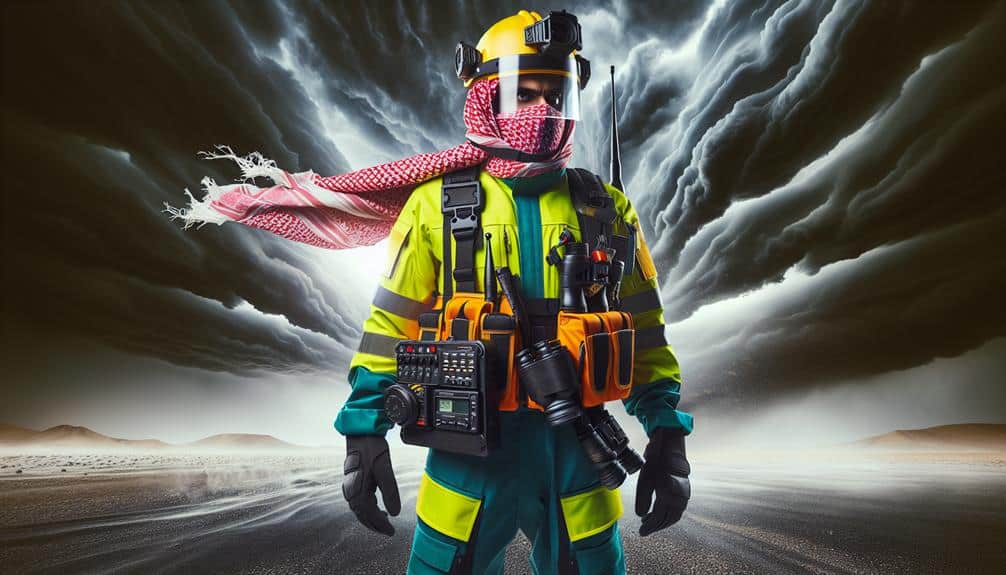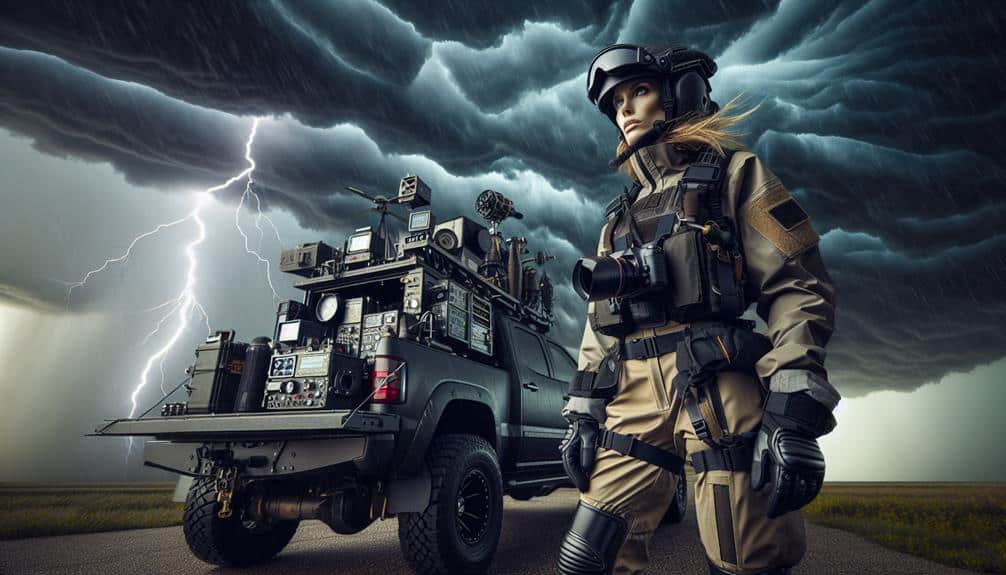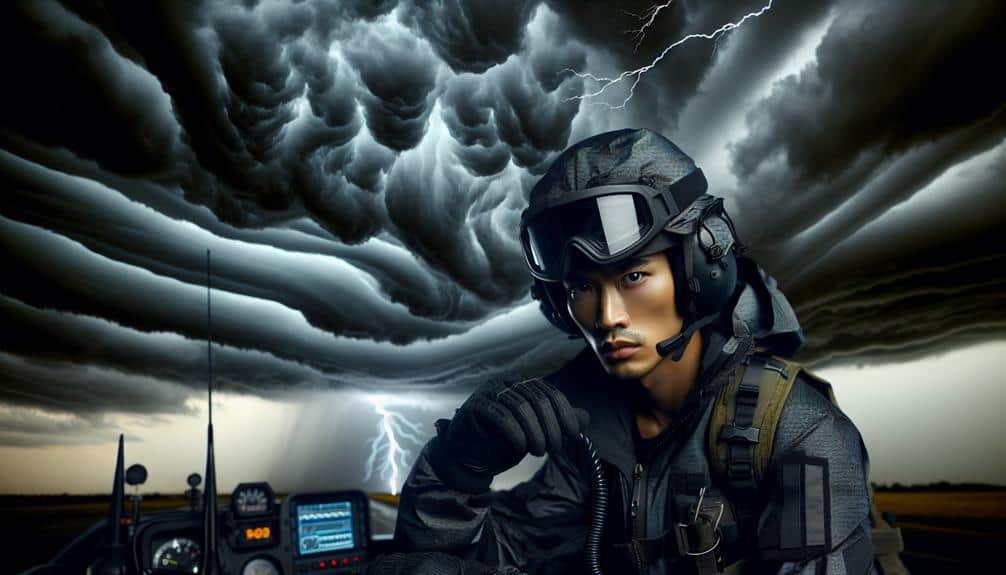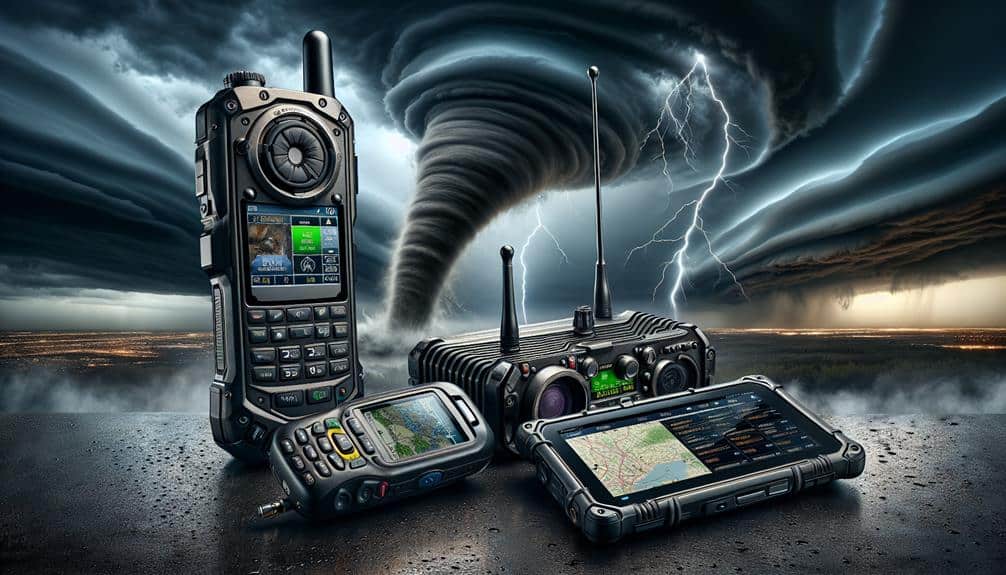We prioritize using cutting-edge tools to guarantee our safety while storm chasing. High-resolution radar systems offer real-time data on storm formations, while mobile apps provide instant meteorological updates. Advanced anemometers measure wind speed and direction, aiding in storm intensity evaluation. Reliable GPS devices ensure precise navigation, and durable storm shelters protect against severe weather. Emergency communication tools, like satellite phones and NOAA weather radios, keep us connected and informed. Protective clothing and gear provide critical defense against harsh conditions. Together, these tools enhance our ability to track storms safely and make informed decisions in the field. Further exploration will provide deeper insights into their functionalities.
Key Points
- High-resolution radar systems offer real-time data for tracking severe weather, pinpointing storm locations, intensity, and movement.
- Mobile weather apps provide real-time storm tracking, visualization, and severe weather alerts for enhanced safety.
- Advanced anemometers measure wind speed and direction precisely, aiding in evaluating storm intensity and trajectory.
- Reliable GPS devices ensure accurate location tracking and real-time navigation updates for informed storm chasing decisions.
High-Resolution Radar Systems
High-resolution radar systems provide storm chasers with critical, real-time data to accurately track and analyze severe weather formations. These systems enable us to pinpoint the exact location, intensity, and movement of storms. By utilizing advanced Doppler radar technology, we can detect wind patterns, precipitation rates, and potential rotation within storm cells. This level of detail is essential for effective storm tracking and weather monitoring, allowing us to make informed decisions quickly.
The radar's high-resolution imagery offers a granular view of storm structures, which is crucial for identifying tornado genesis and other severe weather phenomena. Real-time updates help us stay ahead of rapidly changing conditions, ensuring we can adjust our routes and strategies promptly. This capability not only enhances our safety but also maximizes the efficiency of our storm chasing efforts.
Moreover, the integration of dual-polarization radar further refines our data by distinguishing between different types of precipitation. This feature aids in accurately evaluating hail size, rainfall intensity, and detecting debris signatures, which are vital for understanding and predicting storm behavior.
High-resolution radar systems are indispensable tools for those of us dedicated to storm tracking and weather monitoring, empowering us to chase storms with both precision and confidence.
Mobile Weather Apps
In addition to high-resolution radar systems, mobile weather apps provide us with up-to-the-minute meteorological data directly on our smartphones, allowing for quick and well-informed decision-making in the field. With real-time storm tracking capabilities, these apps enable us to visualize the storm's path, intensity, and potential impact zones, ensuring we can adapt our strategies on the fly.
Many mobile weather apps offer severe alerts that notify us of imminent weather threats, such as tornadoes, flash floods, and lightning strikes. These alerts are essential for safety-conscious chasers who need to stay ahead of rapidly changing weather conditions.
Apps like RadarScope and WeatherBug Elite are equipped with advanced tools for analyzing storm development, including velocity data and precipitation estimates, providing a detailed overview of the storm environment.
Advanced Anemometers
Advanced anemometers provide us with precise measurements of wind speed and direction, important for understanding storm dynamics and making informed decisions in the field. By offering real-time wind measurement, these devices allow us to evaluate the intensity and trajectory of storms with a high degree of accuracy. This information is vital for both safety and strategy, helping us anticipate the storm's path and potential hazards.
The technology behind advanced anemometers has developed significantly. Modern devices use ultrasonic sensors, which offer superior performance compared to traditional cup or vane anemometers. These sensors measure wind speed and direction without any moving parts, reducing mechanical wear and increasing reliability. The data collection process is streamlined, with digital outputs that can be easily integrated into our broader meteorological systems.
Furthermore, advanced anemometers often come equipped with Bluetooth or Wi-Fi capabilities, allowing us to transmit data to our mobile devices or laptops instantly. This connectivity ensures that we can make real-time adjustments to our positioning and strategy, maximizing our effectiveness in the field. By leveraging these advanced tools, we enhance our ability to track storms accurately and stay safe while doing so.
Reliable GPS Devices
When we're out storm spotting, dependable GPS devices are essential for accurate location tracking. These devices must be durable and weatherproof to withstand harsh conditions.
Additionally, real-time navigation updates keep us informed and safe, allowing us to make quick, informed decisions.
Accurate Location Tracking
Why do reliable GPS devices play a critical role in ensuring accurate location tracking for storm chasers?
As storm chasers, we depend on precise positioning to navigate towards and away from severe weather systems safely. Reliable GPS devices offer the accuracy we need. Unlike basic navigation tools, these devices integrate satellite imagery to provide real-time data, ensuring we're aware of our exact location relative to the storm.
Accurate location tracking is indispensable for storm prediction and safety. When we're in the field, timing and precision can mean the difference between a successful chase and a dangerous encounter. Advanced GPS devices help us avoid areas where storms are likely to develop intensely. They work seamlessly with meteorological software, giving us the edge in predicting storm movements.
Moreover, GPS devices with high accuracy reduce the risk of getting lost or stranded in unfamiliar terrain. For those of us who thrive on the freedom to explore nature's most powerful phenomena, these devices are essential. By combining satellite imagery with real-time tracking, they empower us to chase storms effectively while minimizing risks. Essentially, they're our navigational lifeline in the unpredictable world of storm chasing.
Durable and Weatherproof
Durability and weatherproofing are important features for dependable GPS devices, guaranteeing they withstand the extreme conditions storm chasers frequently encounter. We need equipment that can handle heavy rain, strong winds, and flying debris. A sturdy GPS device with an IP67 rating or higher ensures that it's both dust-tight and protected against water immersion. This level of protection lets us focus on tracking the storm without worrying about our gear failing.
In our line of work, we also heavily depend on waterproof cameras and robust tripods to document storm activity accurately. These tools, like our GPS devices, must endure harsh environments. A GPS unit encased in tough housing can resist impacts and continue functioning even if dropped or struck by debris. This reliability is essential when we're out in the field where conditions can change rapidly.
Furthermore, a dependable GPS device should feature a long battery life and clear, easy-to-read displays. These attributes guarantee continuous operation and clear visibility, even in dim or severe weather conditions. By investing in durable and weatherproof GPS devices, we enhance our ability to chase storms safely and effectively, granting us the freedom to explore without constraints.
Real-time navigation updates are crucial for storm chasers, enabling us to adapt swiftly to rapidly changing weather patterns. Reliable GPS devices, integrated with cutting-edge satellite imagery and storm prediction algorithms, provide us with the precise data we need to navigate safely and efficiently. These devices don't just show us where we are; they offer real-time insights into storm movements, helping us stay one step ahead.
Our reliance on these GPS devices extends beyond personal safety. In emergency response situations, accurate navigation can mean the difference between life and death. When communities are at risk, our ability to deliver timely and precise reports can greatly enhance community safety. The combination of reliable GPS data and real-time weather updates ensures that we can provide first responders with the information they need to act swiftly and effectively.
Furthermore, integrating satellite imagery with GPS devices allows us to visualize the terrain and storm developments simultaneously. This integration is particularly valuable for making informed decisions during storm chases, guaranteeing that we can avoid hazardous areas and prioritize routes that maximize both safety and data collection.
For us, these tools are indispensable for effective storm chasing.
Durable Storm Shelters

When contemplating safety measures, investing in durable storm shelters is essential for enduring severe weather events. For those of us who crave the thrill of storm chasing while prioritizing safety, having a reliable shelter can make all the difference.
There are various options to ponder, each with its own set of advantages and technical specifications.
- Underground Bunkers: These provide maximum protection by utilizing the earth's natural insulation. Many models are portable, allowing us to set up in prime locations. The primary advantage is their ability to withstand even the most severe weather conditions due to their subterranean placement.
- Steel Reinforced Shelters: Above-ground shelters made from steel-reinforced materials offer robust protection. These are particularly useful for those who need quick accessibility and mobility. Their strength lies in the steel reinforcement, which can withstand high winds and flying debris.
- Combination Shelters: Some innovative designs incorporate both underground and above-ground elements, providing a hybrid solution that maximizes safety and accessibility.
- Community Shelters: For those of us chasing storms in populated areas, community storm shelters can offer a reliable refuge. These are often built to accommodate multiple people and are strategically located for accessibility.
Emergency Communication Tools
Effective emergency communication tools are necessary for ensuring our safety and coordination during storm chasing expeditions. One of the most reliable methods is satellite phone communication. Unlike cell phones, satellite phones maintain connectivity in remote areas, allowing us to relay vital information regardless of our location.
Emergency beacon alerts are another indispensable tool. They provide a lifeline by transmitting our coordinates to rescue teams, ensuring that help can find us even when conventional methods fail.
Weather radio updates are also essential. NOAA weather radios offer real-time alerts about severe weather conditions, giving us the advanced warning necessary to make informed decisions on the go.
Integrating these with text message notifications can enhance our situational awareness. Text alerts from local weather services deliver timely information directly to our mobile devices, complementing other alert systems.
Protective Clothing and Gear

Proper protective clothing and gear are essential for ensuring our safety in the unpredictable conditions of storm chasing. We need to equip ourselves with attire that offers both layered protection and breathable materials to maintain comfort without sacrificing safety.
The technical aspects of our gear should be non-negotiable, focusing on impact resistance and reinforced seams to withstand the harsh environments we may encounter.
Here are four key items to contemplate:
- Layered Jackets: These jackets should provide multiple layers for protection against wind and rain while incorporating breathable materials to prevent overheating. A good jacket will have reinforced seams to resist tearing under stress.
- Impact-Resistant Helmets: Helmets designed for storm chasing must offer robust impact resistance. Look for models with additional features like adjustable straps and ventilation to balance safety and comfort.
- Sturdy Boots: Footwear should have reinforced toes and strong ankle support. Breathable materials are a plus, ensuring our feet stay dry and comfortable during long chases.
- Protective Eyewear: High-quality eyewear that offers both UV protection and impact resistance is critical. This gear should shield our eyes from debris and harmful rays while providing clear visibility in varying weather conditions.
Frequently Asked Questions
What Are the Best Practices for Storm Spotting Safety?
We should always follow emergency protocols, and guarantee our equipment is reliable. Effective communication strategies are essential, and we must take all necessary precautions. Being prepared and informed keeps us safe while giving us the freedom to chase storms.
How Can I Identify Different Types of Severe Weather Conditions?
Identifying storm features is like reading nature's warning signs. We analyze cloud formations, such as supercells and shelf clouds, to recognize severe weather conditions. By understanding these patterns, we gain the freedom to anticipate and respond effectively.
What Is the Optimal Time to Go Storm Chasing?
We should analyze weather patterns to determine best times for storm chasing. Typically, late spring offers the most favorable conditions. Let's also prioritize safety precautions, ensuring we're prepared for any unexpected severe weather developments.
How Do I Join a Local Storm Spotting Community?
Joining a local storm spotting community is like finding a hidden treasure. We start by attending local meetups and participating in online forums. These platforms connect us with experienced spotters, providing knowledge and fostering freedom in storm chasing.
What Training Is Available for Amateur Storm Spotters?
For the Current Question, we can enhance our skills through online courses and hands-on workshops. Online courses offer flexibility and detailed material, while hands-on workshops provide practical experience, ensuring we're well-prepared for storm spotting.


